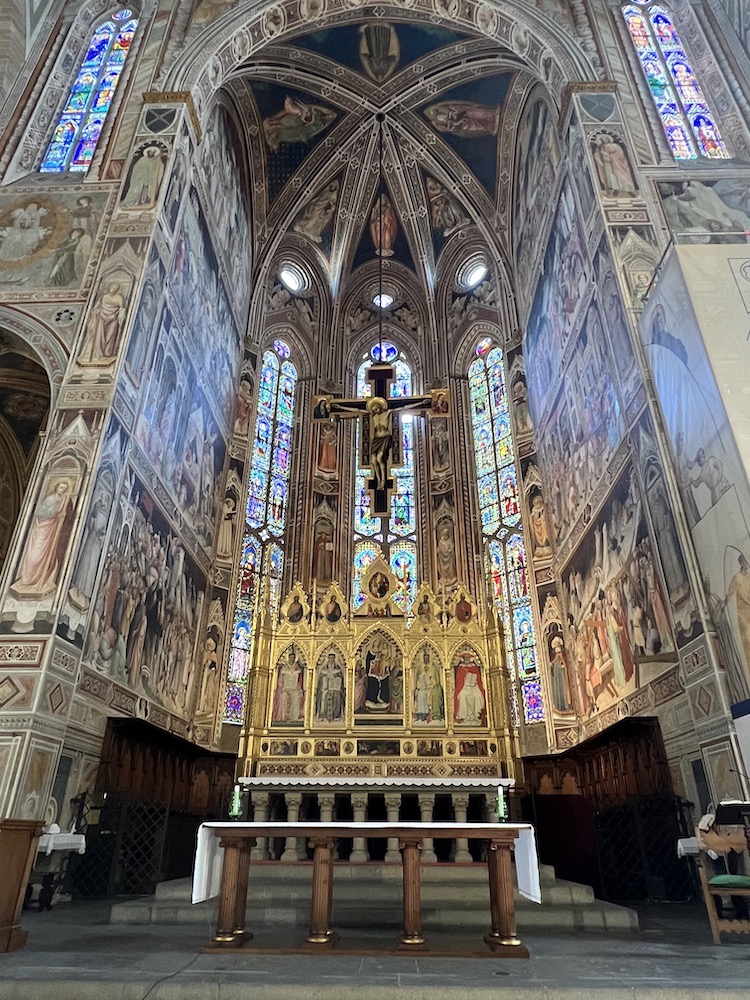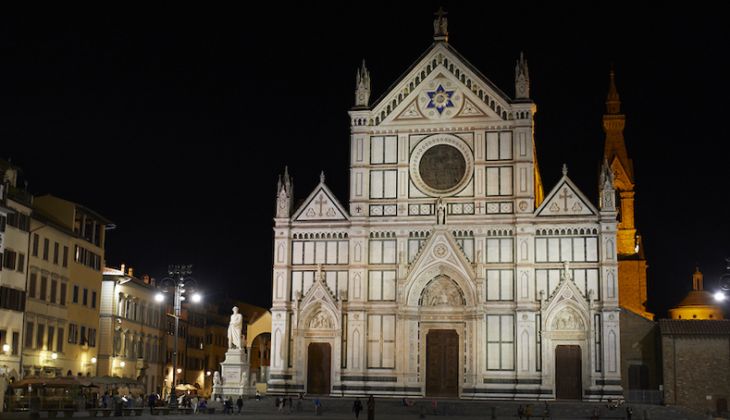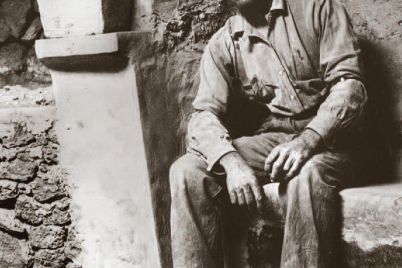Every year millions of tourists visit the city of Florence and flock to the Uffizi Gallery for its extraordinary collection of Italian Renaissance paintings. Or they visit the Duomo that dominates the city’s skyline. But nearby is the Basilica of Santa Croce, founded by Saint Francis of Assisi, considered by many as the most important church in Florence.
The followers of Saint Francis first visited Florence in 1209, congregating outside the city walls and living among the poor. At first, the local population perceived the Franciscans as thieves and beggars, and they tried to kick them out. The Franciscans spent their time preaching, advocating the abandonment of material possessions, and refusing money from anyone. It took some time for the Florentine people to accept them as part of their community and respect their frugal way of living. But after a short time and for no apparent reason, the Franciscans packed up their belongings and returned to Assisi.
In 1211, Francis decided to visit Florence for himself. After experiencing a personal crisis, he abandoned his dream of becoming a knight and decided to follow a spiritual path, living among the poor and committing to a life modelled after Christ. He stayed near the Arno River, in a marshy area that often flooded. Here, the Franciscan friars built a small oratory that would eventually become Santa Croce.
The Franciscans wanted to build a church using simple structures that could house large numbers of people. The church took decades to build, finally being completed in 1294. In the 19th century the Jewish architect Niccolo Matas re-designed the façade and placed the Star of David near the rooftop. The exterior of the church that stands today is made of neo-gothic marble. On its side are beautiful gothic windows that allow light to fill the church.
Once inside, the church reveals its massive size. It encompasses sixteen chapels and the nave spans 115 meters. The centre of attention is the high altar with Jesus on the cross. Surrounding the altar are large frescoes created by Agnolo Gaddi that tell the story of the True Cross on which Christ was crucified. Two-thirds of the interior is covered by frescoes that at the time were a bible for the poor.
Santa Croce is home to a rich collection of 4,000 works of art, from the 13th to the 20th centuries; much of the art remains in its original setting. The works of Donatello and Filippo Brunelleschi, two of the fathers of the Renaissance, are housed in the church. The Pazzi Chapel, located on the side of the church, was designed by Brunelleschi. It is representative of early Renaissance architecture, with its geometric proportions that exude spirituality. The church’s most iconic work, the Crocefisso di Santa Croce, is by the artist Cimabue. It is a realistic depiction of Christ on the cross and a portrayal of human suffering. It has influenced major artists through the ages. The work was severely damaged during a flood in 1996.

Tomb of Michelangelo (left) and tomb of Galileo (right) in the Basilica of Santa Croce, Florence (photos courtesy of the author)
During the Middle Ages cemeteries did not exist, and the faithful were buried within churches and convents. At one time, Santa Croce had one thousand people buried beneath its stone floors; today, two hundred and fifty graves remain. Some of Italy’s most illustrious figures – a who’s who of artists, scientists, and writers – have their tomb in the church. Three of the most famous are Michelangelo, Galileo, and Machiavelli, who each endured great personal suffering to advance their work and beliefs; and even in death, their lives were marked by controversy.
Michelangelo exiled himself to Rome to live under the rule of the pope, as he wanted no part of living under Alessandro de’ Medici, whom he felt ruled Florence like a tyrant. When Duke Cosimo I de’ Medici heard of Michelangelo’s passing in 1564, he wanted to honour him with a state funeral and a burial in Florence. Michelangelo’s nephew and heir was given the dubious task of stealing the corpse. He would do so in the middle of the night, placing the corpse in a bale of hay and whisking it out of the city. When the pope found out, he was powerless to do anything about it. On Michelangelo’s tomb sits a bust surrounded by three crying women representing the arts of painting, sculpture, and architecture as they mourn his loss.
Galileo was considered a heretic for asserting that the Earth revolved around the sun. When he died in 1642, the Inquisition refused to have him buried on consecrated ground. His friends buried Galileo’s body in a small room inside the basilica. Holy Roman Emperor Ferdinand II raised the money for a tomb in Galileo’s honour, but Pope Urban VIII refused to build the tomb and Galileo’s resting place remained unmarked for decades.
Finally, in 1992, three hundred and fifty years after Galileo’s death, the Catholic Church acknowledged that mistakes were made during the Council of the Inquisition in Galileo’s trial. The New York Times reported that “…it’s official: the Earth revolves around the sun, even for the Vatican.” Pope John Paul II stated that Galileo’s verdict of heresy had become “the symbol of the Church’s supposed rejection of scientific progress, or of ‘dogmatic’ obscurantism opposed to the free search for truth.” Galileo’s tomb sits across from Michelangelo’s. Because Michelangelo died close to the day when Galileo was born, some believe that Michelangelo’s spirit leaped into Galileo’s body. Although they never met, both men pushed humanity out of the Dark Ages. They are buried a few meters apart and remain kindred spirits.

High Altar, Basilica of Santa Croce, Florence (photo courtesy of the author)
Machiavelli’s fate was often tied to the political fortunes of the Medici family. His books were banned and the Church made him persona non grata for 250 years. It was not until the Enlightenment that an Englishman named George Nassau Cowper took an interest in Machiavelli’s books and wanted to give him a proper burial. Rome objected to Machiavelli’s atheism, and it would take the intervention of the Bishop of Pistoia, Scipione de Ricci, to convince the pope that Machiavelli had received his last rights before his death and was a faithful Christian. With the pope’s approval, Italy’s greatest political thinker was given a proper monument in 1787.
In 1804, Italy was ruled by Napoleon, who issued an edict that all burials must take place outside city walls, and burial monuments must be the same size. Napoleon had equality, health, and hygiene in mind, but his edict helped to unify Italy as a nation. It prompted poet Ugo Foscolo in 1807 to compose his poem I Sepolcri in which he speaks of Santa Croce as a lieu de memoire, “the church that houses Italy’s glories whose virtues must serve as an inspiration for all.” It was an important moment in the history of Santa Croce, as people began to see the church not as the Pantheon of Florence but as the Pantheon of the Italian nation.
Santa Croce’s importance cannot be understated, as it is not only the final resting place of many great Italians, but a treasure trove of art and religion. Its rich history helped unify Italy as a nation. When the poet Lord Byron first laid eyes on Santa Croce he declared that he was “drunk with beauty.”
Based in Toronto, Francis Crescia writes about political, economic, and cultural issues.




